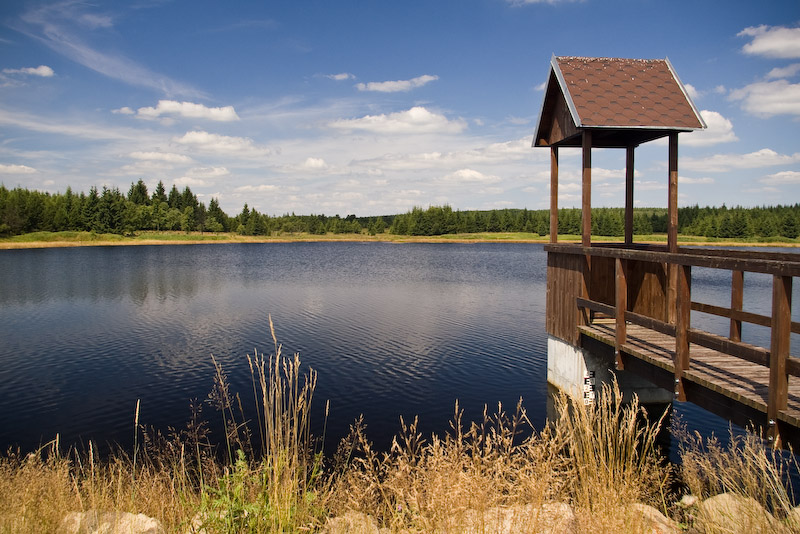Novodomská rašelinište

Starý rybník - Krásný rybník poblíž Novodomských rašeliništ / Nice lake nearly peatbog
[CZ]
V Krušných horách, mezi obcemi Načetín a Hora Sv. Šebestiána (v nadmořské výšce 810 až 830 m) leží Národní přírodní rezervace Novodomské rašelinište. Předmětem ochrany je rozvodnicové vrchoviště s mohutnými podzemními prameny, které je tvořeno dvěma samostatnými rašeliništi – Načetínským a Jezerním, které jsou propojeny podmáčenou a rašelinnou smrčinou. Toto rašeliniště, i přes dřívejší imisní zatížení zdejší přírody, patří k nejlépe zachovalým v Evropě.
Geologie
Z hlediska geologie je území tvořeno horninami krušnohorského krystalinika, které náleží mezi tzv. šedé ruly (starší, proterozoikum) a červené ruly (mladší, svrchní proterozoikum až spodní paleozoikum). Šedé ruly jsou zastoupeny biotitickou pararulou, červené ruly pak dvojslídnou ortorulou. Rulové zvětraliny jsou překryty mohutnou vrstvou čtvrtohorních organických rašelinných sedimentů.
Flora
Na biotop rašeliniště je vázána typická flóra, především rozsáhlé porosty borovice kleče, Pinus mugo pseudopumilio, jejichž porosty si místy zachovávají přirozenou skladbu a značnou biodiverzitu. V podrostu se vyskytují typické rašelinné druhy, jako rojovník bahenní (Ledum palustre), bříza zakrslá (Betula nana), kyhanka sivolistá (Andromeda polifolia), rosnatka okrouhlolistá (Drosera rotundifolia), klikva bahenní (Oxycoccus palustris) a šicha černá (Empetrum nigrum). Na otevřenejších plochách tvoří rozsáhlé porosty suchopýr pochvatý (Eriophorum vaginatum). V okrajových částech pak nalezneme mohutné exempláře břízy karpatské (Betula carpatica).
Na okrajích rezervace byl v minulosti vysázen nepůvodní a nežádoucí smrk pichlavý (Picea pungens).
Fauna
V této lokalite převládá fauna horských lesů. Z nejvýznamnejších druhu zde nalezneme tetřívka obecného (Tetrao tetrix), sýce rousného (Aegolius funereus), kulíška nejmenšího (Glaucidium passerinum), motáka pilicha (Circus cyaneus), křivku obecnou (Loxia curvirostra) či výjimečně zde zastihneme jeřába popelavého (Grus grus). V minulosti se zde pravidelne vyskytoval i tetřev hlušec (Tetrao urogallus), jehož výskyt však již delší dobu nebyl potvrzen.
Velmi významná je fauna bezobratlých živočichů vázaných na rašelinné biotopy.
K uznání logu je třeba vyfotografovat sebe (nebo - dle nových regulí - "osobní předmět" jako důkaz, že jste navštívili dané místo) před informační tabulí na uvedených souřadnicích (prosím, pozor na spoiler), fotku připojit k logu a zaslat mi odpovědi na tyto otázky:
- Jakou mocnost mají organické rašelinné sedimenty?
- Jaká je (podle informační tabule) rozloha Novodomského rašeliniště, včetne ochranného pásma ?
Upozornění: K cestě na místo určení nelze použít motorová vozidla. Použijte kolo, popřípade vlastní nohy.
[EN]
In Krušné hory (Ore Mountains), between villages Načetín and Hora Sv. Šebestiána (at elevations of 810 to 830 metres) lies National natural park Novodomské rašeliniště (peatbog). The subject of the protection is a watershed peatbog complex with powerful springs of underground water, which consists of two separate peatbogs – the Nacetínské and Jezerní peatbogs. These peatbogs, despite an earlier air pollution burden of nature, is one of the best preserved in Europe.
Geology
The NNR territory is built of the minerals of the Krušné hory Crystalinicum, which range from older grey gneisses of Proterozoic age and younger red gneisses of Upper Proterozoic to Lower Paleozoic age. The grey gneisses are represented by biotite paragneiss and the red gneisses by two-mica orthogneiss. The weathered gneisses are covered by a thick layer of Quaternary organic peaty sediments.
Flora
Extensive pine scrub growths - Pinus x pseudopumilio are typical for the reserve and their growths have maintained a natural composition and considerable biodiversity in place. Typical peatbog species in the undergrowth include labrador tea (Ledum palustre), dwarf birch (Betula nana), marsh andromeda (Andromeda polifolia), round-leaved sundew (Drosera rotundifolia), the cranberry Oxycoccus palustris and crowberry (Empetrum nigrum). Extensive growths of hare’s-tail cottongrass (Eriophorum vaginatum) can be found in more areas. Some very large carpathian birch trees (Betula carpatica) can be found around the fringes of the reserve. The non-indigenous and undesirable prickly spruce (Picea pungens) was planted around the fringes of the reserve in the past.
Fauna
The fauna of the Novodomské peatbogs is that which is typical for mountain forests and significant bird species in the area include black grouse (Tetrao tetrix), Tengmalm’s owl (Aegolius funereus), pygmy owl (Glaucidium passerinum), hen harrier (Circus cyaneus), crossbil (Loxia curvirostra) and occasionally cranes (Grus grus) can be seen here. The capercaillie (Tetrao urogallus) was an inhabitant of the reserve in the past but its presence has not been documented recently. The invertebrate fauna which is bound to the peatbog biotypes is also of great significance.
To recognise your log you must take a photo of yourself (or, according to rules, "a personal item" to prove you visited the site) in front of information board on those coordinates (beware of spoilers), add picture to log and mail me answers to these questions:
- How thick is layer of Quaternary organic peaty sediments?
- What is total area of Novodomská rašeliniště, including the protection zone, according to information board?
Attention: You cannot use car or motorcycle for transport to final coordinates. Use bicycle or your own legs.

Voda zbarvená rašelinou / Water coloured by peat
Za prípadné zarazení mezi Favorites (v záhlaví listingu) děkuji.